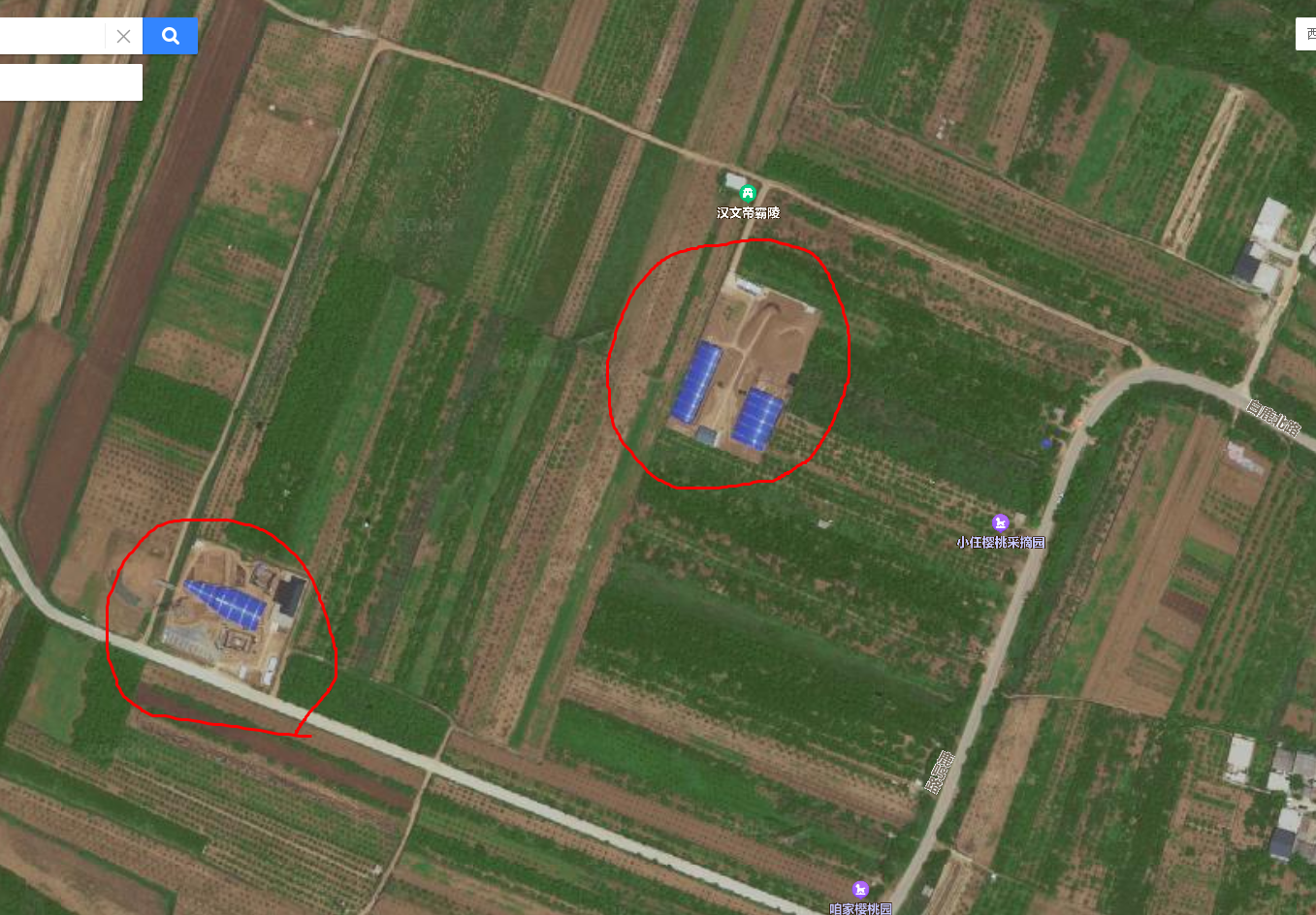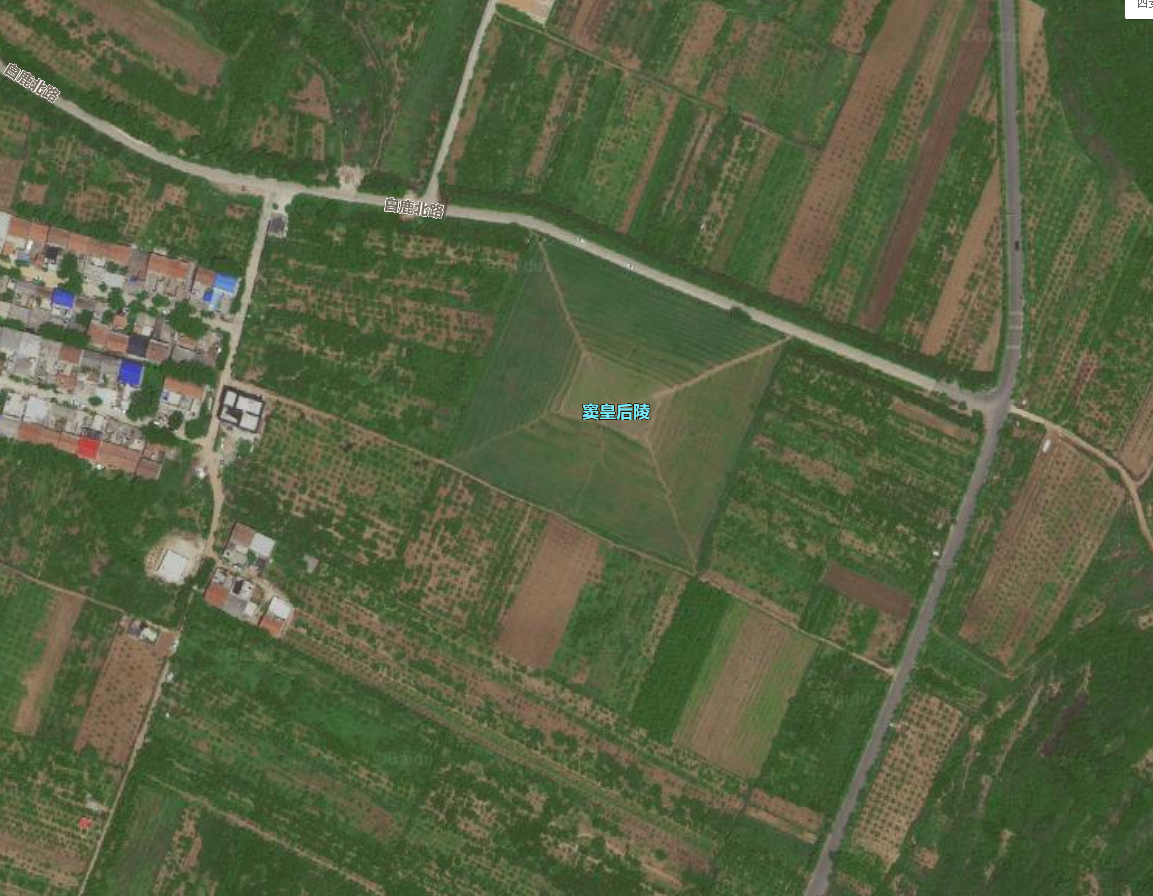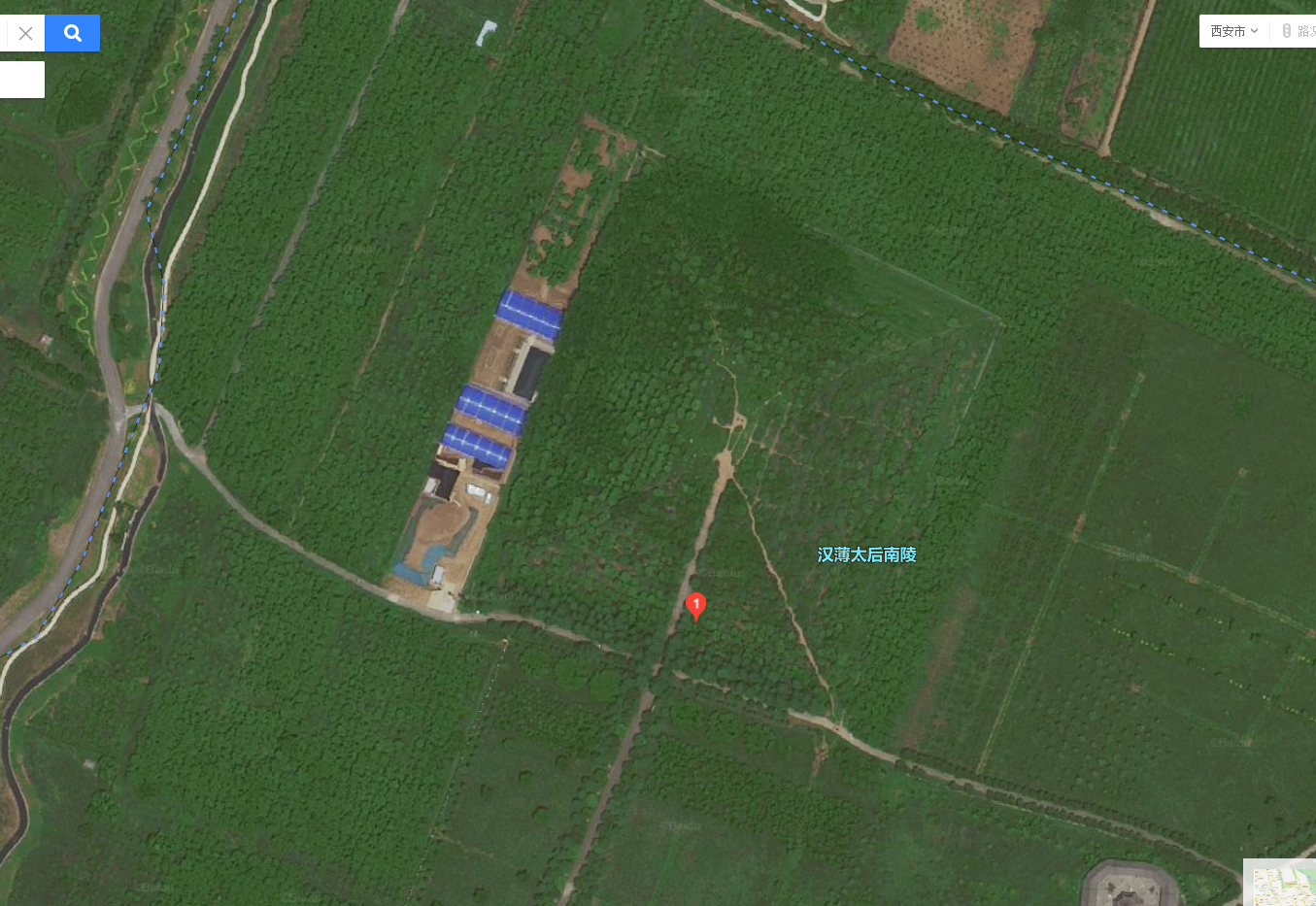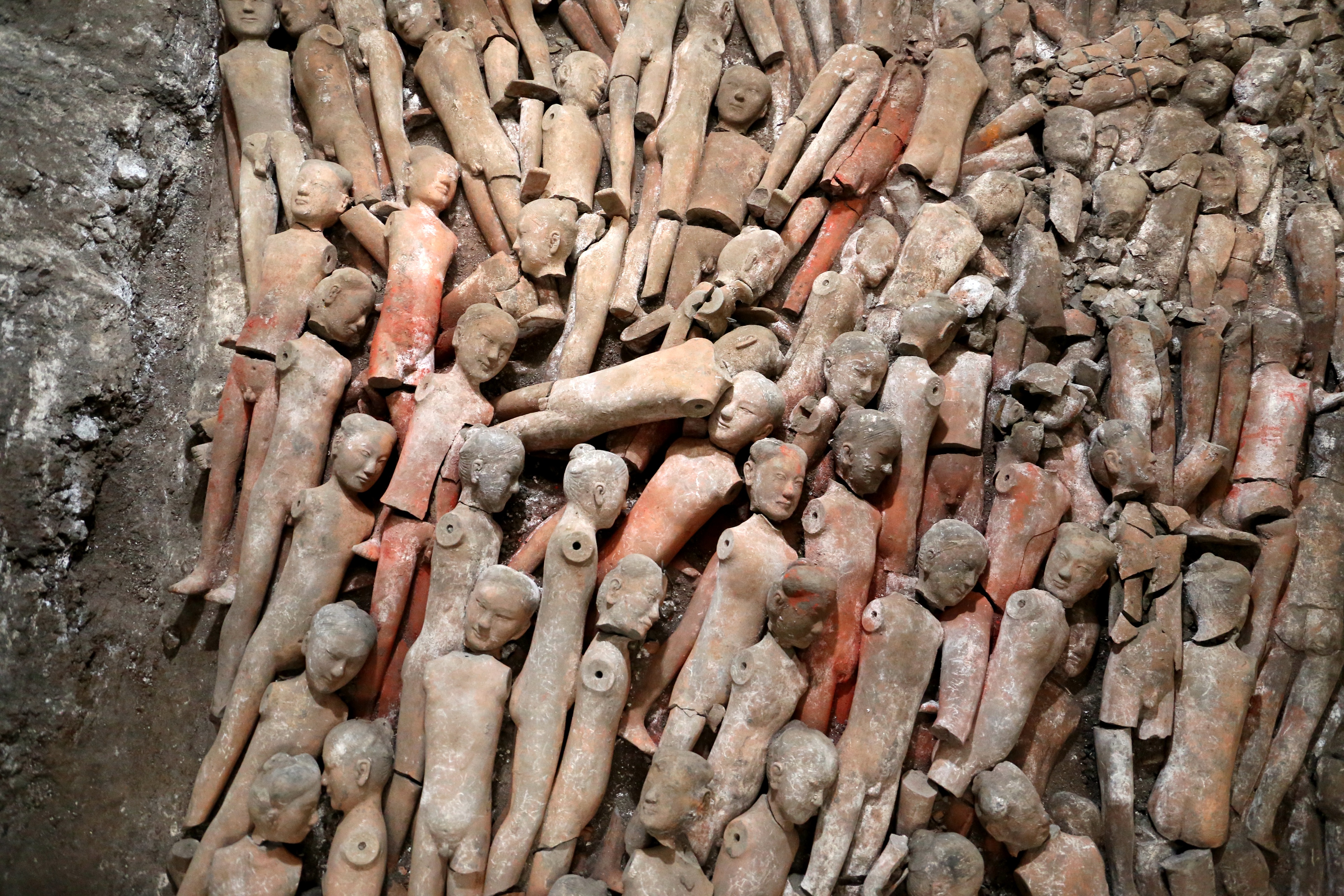근자 중국 고고학이 묵직한 발견 소식을 전했으니, 한漢 제국을 건설한 유방의 서자이자 전한前漢 혹은 서한西漢 왕조 제4대 황제인 문제文帝와 관련한 무덤 위치 확정 소식이 그것이라
사기史記라든가 한서漢書 같은 데서는 그가 죽어 묻힌 곳을 패릉覇陵이라 하거니와, 이 패릉이 정확한 위치가 논란이 좀 있었거나 잘못 알려졌던 모양이라, 이번에 섬서성 성도 서안西安 시내를 중심으로 남쪽으로 약간 치우친 동쪽 지점 평야지대에 위치하는 곳을 판 결과 그의 무덤을 찾았다는 것이니,
그러면서 이참에 그 인근에 있는 그의 엄마 박태후薄太后 무덤도 파제낀 모양이라, 그것을 바이두 위성사진을 통해 검색하면 아래와 같다.
<바이두위성 사진을 통해 검색한 박태후릉薄太后陵>
百度地图
map.baidu.com
이 박태후릉薄太后陵은 우리의 사적에 해당하는 전국중점문물보호단위全国重点文物保护单位라, 편호编号가 7-0669, 2013년 등록이다.
지금의 섬서성陕西省 서안시西安市 패교구灞桥区 적새가도狄寨街道 포기새촌鲍旗寨村 서쪽 800미터 지점이라
기원전 173년에 수건修建했다.
유방은 정비가 그 유명한 여걸 여후吕后라, 박태후는 일개 비첩에 지나지 아니해서 유방 무덤인 장릉长陵에는 오직 정식 마누라만 묻힐 수 있어, 비첩인 박씨는 딴 데로 쫓겨났지만 그래도 그 소생이 황제가 되자 그 생모라 해서 대접을 제대로 받았다.
아들 문제가 묻힌 패릉覇陵 남쪽에 있다 해서 남릉南陵이라 일컬어졌다.
봉분이 피라미드형인 복두형覆斗形이라 그 밑변은 东西 140미터,南北 173미터라 남북 방향이 약간 긴 정방형 가까운 평면 방형이다.
봉분 높이는 24미터라 봉황대 혹은 황남대총과 거의 같다.
진晋 민제愍帝 건흥建兴 3년(315)에 도굴됐다는데 그 피해 양상이 어떤지는 알 수 없다.
1975년, 백록원白鹿原이라 일컫는 현재의 능 주변에서 적새공사狄寨公社 张李大隊(지금은 灞桥区 狄寨社区 鲍旗寨)라는 데서 수고水库를 만들 적에 이 무덤 부장갱坑이 출현하고 거기서 大熊猫、爪哇犀、马、羊、狗를 비롯한 동물뼈가 발견됐다.
나중에 드러났지만 이는 무덤 주변에 마련한 배장갱陪葬坑 20곳 중 장방형长方形 갱동坑洞 중 한 곳이고, 각 부장갱에는 썩어 문드러진 나무 우리에 동물뼈들이 있었다.
일부 동물뼈 곁에선 이들한테 먹이를 주기 위한 도기 그릇이 발견되기도 했다.
앞 바이두 지도를 상술해서 보면 다음과 같다.
후대에 아들인 한 문제文帝 유항劉恒(203~157년 7월 6일 BC)의 생모로 한 제국 창건주 유방劉邦의 첩이 되어 본명은 상실하고 성이 박씨이며, 첩 중 하나라 해서 박희薄姬라고만 일컬었다가 나중에 그의 아들 유항이 당당히 황제가 됨으로써 태후로 격상되어 박태후薄太后라 일컬은 여인이 잠든 남릉南陵이 맨아래쪽에 위치하며
그 북쪽 동쪽으로 약간 치우친 북쪽 2킬로미터 지점에 이번에 찾아냈다는 한 문제 패릉覇陵이 위치하거니와, 다시 이 패릉 동쪽 800미터 지점에 그의 황후인 두황후竇皇后(?~135년 6월29일 BC) 기猗, 그러니 그는 풀네임이 두기竇猗라, 아무튼 그의 본마누라 묻힌 두황후릉이 있다.

이 지도를 보면 북동쪽에 문제의 패릉과 그의 마누라 두태후능이 있고 그 남쪽에 박태후가 묻힌 남릉이 있다.

이번에 찾았다는 패릉이다.
파란색 지붕 가설 덧집을 씌운 발굴지점이 보인다.
매장주체부가 어느 지점인지 나는 모르겠다.
이를 보면 패릉은 이미 잦은 농지 개량으로 봉분은 다 날아가서 밀밭 같은 농경지로 쓰임을 본다.

그 동쪽 두태후능이라 봉분이 잘 남았음을 본다.
이쪽은 발굴이 이뤄진 흔적이 안 보인다.

박태후릉인데 봉본 서쪽 지점을 집중 조사 중임을 위성 사진이 보인다.
결국 이번에 발굴한 지점은 문제의 패릉과 그의 생모 박태후릉 두 군데가 되겠다.
아래는 섬서성고고연구원이 정리한 이번 조사 개요다.
http://www.shxkgy.cn/index.php?m=home&c=View&a=index&aid=971
陕西省考古研究院
12月14日,国家文物局召开“考古中国”重大项目重要进展工作会,副局长宋新潮出席并讲话。本次会议采用网络视频会议与线下会议相结合形式,分别听取陕西西安江村大墓、河南洛阳正平坊
www.shxkgy.cn
애초 내가 이 소식을 처음 중국 언론을 인용한 국내 언론보도를 접했을 적에는 패릉만 발굴한 줄 알았거니와, 그래서 나 스스로 적지 않은 혼란이 있었으니, 그러다가 다시 검색하니 두 군데 발굴이 있었고 그 각각의 성과를 신화사가 아래와 같이 사흘 간격으로 나뉘어 타전했음을 알았다.
먼저 지난 14일 패릉 확정 발견소식이다.
XINHUA
2021-12-14 20:28:04
Mausoleum of Han dynasty’s third emperor located in China
Beijing, Dec 14 (EFE).- A large mausoleum located in the Chinese city of Xian has been identified as the last resting place of Emperor Wendi of the Han dynasty, ending centuries of mystery about the location of his tomb.
Wendi, or Liu Heng, the third emperor of a dynasty that ruled between 202 BC and 25 AD, became famous for his "frugality and benevolence" and in his more than two decades in power improved the economy and increased the population, according to state agency Xinhua.

The site is located in the town of Jiangcun, on the outskirts of Xian, an area excavated since 2017 where more than 100 ancient tombs and niches have also been found, in addition to more than 1,500 objects among which there are pottery figures, official bronze seals and bows.
Four ramps descend into the burial chamber, located between 27 and 30 meters deep underground and is about 74 meters long and 71 wide.
Ma Yongying, researcher at the Shaanxi Archeology Academy, said the structure and scale of the mausoleum are similar to those of two other well-known emperors of the same dynasty, adding that there are also historical documents that support the hypothesis of archaeologists.

This discovery rules out that Emperor Wendi’s tomb was hidden in the nearby area of Fenghuangzui, where a stone tablet with inscriptions was found that made speculations that there could be the grave of the leader.
The surroundings of Xian, where the famous Terracotta Army is located, are one of the main world archaeological research centers, as the area is one of the main cradles of Chinese civilization.
사흘 뒤 신화사는 다음과 같이 박태후릉 발굴성과를 보도한다.
XINHUA
2021-12-17 21:14:51
Goldware unearthed in tomb of Han Dynasty emperor's mother
XI'AN, Dec. 17 (Xinhua) -- Goldware with prominent multicultural patterns has been found in the tomb of Bo Ji, mother of Emperor Wendi of the Western Han Dynasty (202 BC-AD 25), local authorities said.
The tomb was about 2,000 meters from Emperor Wendi's mausoleum, which is located in Jiangcun Village on the eastern outskirts of Xi'an.

Archaeologists found several gold and silver ornaments, painted pottery figurines, gold, silver and bronze chariots and horse statues made of gold, silver and bronze in some burial pits around the tomb.
Some gold ornaments feature animals such as horses and bears, as well as exotic patterns. This shows that in the Western Han Dynasty, the agricultural civilization of central plains and the nomadic civilization had already been exchanging and merging, said Zhang Wanwan, assistant researcher at Xi'an's institute of cultural relics protection and archaeology.

'NEWS & THESIS' 카테고리의 다른 글
| 한성백제박물관 탁발선비 북위 특별전 사진편 (0) | 2021.12.19 |
|---|---|
| 북위 탁발선비 알선동 유적 축문 탑본 北魏拓跋鮮卑嘎仙洞遺址石刻祝文搨本 (0) | 2021.12.19 |
| 서안西安 강촌대묘江村大墓 서한西漢 문제文帝 패릉覇陵 확정 이해를 위한 기초자료 (0) | 2021.12.16 |
| 서안西安 강촌대묘江村大墓를 한漢 문제文帝 패릉覇陵으로 확정한 중국고고학 (0) | 2021.12.16 |
| 高霊で伽倻文化圏初の祭儀施設を発見, 6世紀の大伽耶遺跡 (0) | 2021.12.15 |




댓글